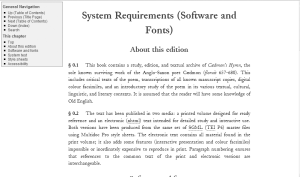About this edition
NOTE (2018): The information on this page refers to the 2005 CD-ROM and is provided for
archival reasons only. The 2018 reissue has been optimised for use with any modern
web browser.
§ S.1
This book contains a study, edition, and
textual archive of Cædmon’s Hymn, the sole
known surviving work of the Anglo-Saxon poet Cædmon (floruit 657-680). This includes critical texts of the poem,
transcriptions of all known manuscript copies, digital colour facsimiles, and an
introductory study of the poem in its various textual, cultural, linguistic, and
literary contexts. It is assumed that the reader will have some knowledge of Old
English.
§ S.2
The text has been published in two media: a
printed volume designed for ready reference and an electronic (xhtml) text intended for detailed
study and interactive use. Both versions have been produced from the same set of SGML (TEI P4) master files using Multidoc Pro style
sheets. The electronic text contains all material found in the print volume; it also
adds some features (interactive presentation and colour facsimiles) impossible or
inordinately expensive to reproduce in print. Paragraph numbering ensures that
references to the common text of the print and electronic versions are
interchangeable.
Software and fonts
§ S.3
The xhtml text can be read using
commercially available internet browsers and is intended for general use. The SGML source text requires specialised
computer knowledge and software and is not intended for the general reader. The two
versions have identical content: the xhtml text was produced automatically from the SGML master.
§ S.4
To consult the display text, you will need
the following software:
- A modern internet browser capable of displaying unicode characters. As of Spring
2004, acceptable browsers include (in alphabetical order):
- Peter Baker’s Junicode TrueType font
<http://www.engl.virginia.edu/OE/junicode/junicode.html> (also included on this CD-ROM).
System test
§ S.5
If your software is correctly configured,
your screen should look approximately like this:

(Image only.)
§ S.6
If your fonts are correctly installed, you
should see approximately similar characters in both the left and the right hand column
of the following table:
| ā ƿ |

|
If you do not see the same characters in both columns, you may need to (re)install
Junicode on your computer. Consult your system manual for information on the correct
installation of fonts on your system.
Accessibility
§ S.8
The xhtml text has been designed with
accessibility in mind. It complies with applicable W3C standards and allows users to perform
all required actions using a keyboard (or equivalent) rather than a mouse. Tables have
been kept to a minimum and no images (except for manuscript facsimiles) contain textual
content. Images that are included in the edition are all accompanied by shorter and
longer prose descriptions on the “alt” and “longdesc”
attributes. Care has been taken to ensure that documents are comprehensible in xhtml-compatible text-only
readers.

